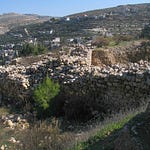There is a strange digression in the middle of the narrative where Moshe is commanded to approach Pharaoh. “So the Lord spoke to Moses and to Aaron, and He commanded them concerning the children of Israel and concerning Pharaoh, the king of Egypt, to let the children of Israel out of the land of Egypt” (Shemot 6:13). The next verse continues, “These are the heads of the fathers' houses: The sons of Reuben, Israel's firstborn…” (6:14) and then the Torah meanders through Reuven and his descendants and Shimon and his descendants. Finally, we get to Levi, the branches of his descendants, eventually arriving at the household of Amram and Yocheved, into which Miriam, Aharon, and Moshe are born. Then before returning to the narrative of Hashem commanding Moshe to address Pharaoh, we are confronted with a few out of place and seemingly redundant verses:
שמות ו (כו) ה֥וּא אַהֲרֹ֖ן וּמֹשֶׁ֑ה אֲשֶׁ֨ר אָמַ֤ר יְהֹוָה֙ לָהֶ֔ם הוֹצִ֜יאוּ אֶת־בְּנֵ֧י יִשְׂרָאֵ֛ל מֵאֶ֥רֶץ מִצְרַ֖יִם עַל־צִבְאֹתָֽם׃ (כז) הֵ֗ם הַֽמְדַבְּרִים֙ אֶל־פַּרְעֹ֣ה מֶֽלֶךְ־מִצְרַ֔יִם לְהוֹצִ֥יא אֶת־בְּנֵֽי־יִשְׂרָאֵ֖ל מִמִּצְרָ֑יִם ה֥וּא מֹשֶׁ֖ה וְאַהֲרֹֽן׃
Shemot 6 (26) That is Aaron and Moses, to whom the Lord said, "Take the children of Israel out of the land of Egypt with their legions.” (27) They are the ones who spoke to Pharaoh, the king of Egypt, to let the children of Israel out of Egypt; they are Moses and Aaron.
If the Torah listed all the tribes and descendants that would be noteworthy. If it just listed Levi to Moshe and Aharon, that might be understandable. But a partial list of Reuven, Shimon, and Levi only is completely puzzling. The conclusion of the genealogical digression is also baffling. This is the 45th mention of Moshe and the 13th mention of Aharon; we know who they are at this point. What are we to learn from this section of the Torah? Rav Hirsch provides some assistance, articulating two takeaways from this peculiar narrative:
Rav Samson Raphael Hirsch - Commentary on Shemot 6:4-30
Now it is of critical importance to present an exact list of their lineage and relations, so as to attest thereby for all time to come that their origin was ordinary and human, and that the nature of their being was ordinary and human…This “certificate of origin” is meant to negate in advance and forevermore any erroneous deification, any illusion of incarnation of Deity in human form. It is meant to uphold this truth: Moshe, the greatest man of all time, was just a man, and the position he attained before God was not beyond the reach of mortal human beings.
The list of names is also meant to negate a second illusion, the opposite of the first and no less dangerous…For although the certificate of origin establishes as a fact the human nature of Moshe and Aharon, it might also have fostered the belief that everyone, without exception, is fit to become a prophet. A person who today is known as a complete idiot could tomorrow proclaim the Word of God. God’s spirit could suddenly descend upon an ignorant and uneducated person and teach him to speak in seventy languages. Indeed, this phenomenon of imagined or pretended prophecy is not uncommon in other circles. In their view, the more intellectually limited and empty-minded the prophet of today was yesterday, the more clearly this sudden transformation attests to a Divine call.
This dangerous illusion, too, is negated by the family register. True, Moshe and Aharon were men and nothing but men, but they were chosen. Had God wished simply to pick the first comer, there were other tribes…branches…houses…God, however, chooses the worthiest and most exemplary to be His emissaries who do His bidding. Before he receives his call, the human being must attain the heights of human virtue…One is chosen only if he has matured on his own to the point that he has become worthy of being chosen.
Rav Hirsch derives two distinct ideas from this narrative. Firstly, it provides context for understanding that the greatest of Jewish leaders are nonetheless human. We recognize the divinely implanted potential in man, but we do not confuse it with Divinity itself. Secondly, we learn that greatness is not random. Progress and development is the result of human initiative and effort, combined with divinely orchestrated opportunity and responsibility.
Rashi picks up on another anomaly in verse which first states “that is Aharon and Moshe” and concludes with “that is Moshe and Aharon” (6:26).
רש"י שמות ו:כו
הוא אהרן ומשה – אילו שהוזכרו למעלה שילדה יוכבד לעמרם, הוא אהרן ומשה אשר אמר וגו'. יש מקומות שמקדים אהרן למשה, ויש מקומות שמקדים משה לאהרן, לומר ששקולים שניהם כאחד.
Rashi Shemot 6:26
That is Aaron and Moses: Who are mentioned above [verse 20], whom Jochebed bore to Amram, [these two] are [the same] Aaron and Moses to whom the Lord said, etc. In some places, [Scripture] places Aaron before Moses, and in other places it places Moses before Aaron, to tell us that they were equal. — [from Mechilta, 7:1]
In what way were Moshe and Aharon equal? We know Moshe is the greatest of all prophets, “And there was no other prophet who arose in Israel like Moses, whom the Lord knew face to face” (Devarim 34:10; see Rambam - Yesodei HaTorah 7:6). They cannot be equal in terms of prophecy. In fact, Aharon and Miriam made this mistake at the end of Beha’alotecha (see Bamidbar 12:1-13).
מלבי"ם שמות ו:כו
הוא אהרן ומשה – אחר שהשלים יחוסם אומר כי שני האחים האלה נשלחו לשני דברים: א] אשר אמר ה' להם הוציאו את ב"י מארץ מצרים, שהוא השליחות שנשלחו אל ב"י להוציאם מא"מ, וזה כולל בין המציאה הגופנית שיוציאו אותם על צבאותם להוליכם אל המדבר, בין היציאה הנפשיית שיבדלו מטומאת מצרים ומדעיתיהם, ובזה היה אהרן העקר ומשה טפל לו, כי הוא לבדי דבר אל ב"י והם נמשכו אחריו יותר שהיה אוהב שלום ורודף שלום, וכמ"ש חז"ל שלכן כתיב במיתתו ויבכו את אהרן וגו' כל ביח ישראל, וע"כ אמר הוא אהרן ומשה:
Malbim Shemot 6:26
Having now recorded their distinguished lineage, the narrative stresses once more that the brothers were dispatched on this mission for a double purpose. One, to bring out the children of Israel from the land of Egypt, which pertains both to the physical exodus: taking the Israelites out from amidst their host people, to send them into the wilderness, and to the spiritual exodus: setting them apart from the defiling practices of the Egyptians and their doctrines. With respect to the latter, Aharon was given the principal role, since he alone would be speaking to the Israelites, being a man who loved peace and always sought to make peace, and whose leadership was for this reason accepted. According to our Sages, that is made clear by Scripture later recording that in mourning for the death of Aharon, they wept ... all the house of Israel. Accordingly, the present verse places Aharon before Moshe.
The Malbim indicates that Moshe and Aharon had different roles. Moshe’s role was more primary when it came to leading the physical exodus from Egypt. But when it came to the spiritual exodus, Aharon was primary and Moshe was in a supporting role. Moshe lead the political exodus while Aharon lead the theological exodus. It’s not that their roles were identical. But they both fulfilled equally essential Divine missions.
The Rav offers a related and perhaps more expansive view of Moshe and Aharon’s respective roles:
Rabbi Joseph B. Soloveitchik - “Engaging the Heart and Teaching the Mind”
A pattern of dual leadership seems to have prevailed during major periods of Jewish history…Both Moses and Aaron were teachers, but their methods and temperaments differed. The two major traditions of teaching may be called that of the king (malchus)-teacher, and that of the saint (kedushah)-teacher. Moses was the prototype of the king-teacher and Aaron represented the saint-teacher. Both of them enlightened minds, molded characters, and propagated the word of God. Both led their communities along righteous paths and made sacrifices for their welfare. Nevertheless, their methods, their approaches, and the media they employed were different. In terms of ultimate objectives, they were very close to each other, but their emphases varied.
The king-teacher address himself to the mind. He engages the intellect, analyzing, classifying, clarifying, and transmitting the details of halachah with precision. He teaches texts and conceptualized thinking, reconciling seeming contradictions and formulating underlying principles. Moses, Maimonides, the Gaon of Vilna, and Rav Chaim Soloveitchik reflect the king-teacher par excellence.
…The saint-teacher communicates with the heart. He tells the heart how to identify its own excited, accelerated beat with the Torah—to feel, not only to understand. He teaches man both loyalty to halachah and the art of cleansing the heart of vulgarity, inhumanity, unworthy sentiments, uncouth emotions, and selfish desires. He teaches how a triumph is to be celebrated when the Almighty has granted success, and how to cope with sadness and grief. The saint-teacher creates a society of intense personal piety and subliminal closeness to God. (Quoted in Chumash Mesoras HaRav, based on Avraham Besdin summary)
The Rav observes two sometimes distinct historical roles. “The king-teacher speaks to a select few, for not all are capable of being scholars; not everyone is qualified to understand an abstract halakhic or scientific concept, let alone contribute to it…Yet one simply cannot convert a whole nation into scholars…By contrast, the saint-teacher is a leader of the masses, for all Jews have hearts which can be set aflame. All Jews possess sensitive souls and see God” (Solovetichik/Besdin, 1993, p.164-165). The ivory tower academic and the skilled practitioner each contribute. We aim for both the intellectual and experiential elevation of the human personality. We must be sensitive to each imperative, and cultivate teachers and leaders to shoulder these equally important responsibilities. The array of qualities and capacities necessary to lead the Jewish people effectively rarely reside in a single individual, but “Jewish leadership is most effective when it combines the mind and the heart in the worship of God” (p.168).
References
Besdin, A. R., & Soloveitchik, J. B. (1993). Reflections of the Rav: Lessons in Jewish Thought. Hoboken, NJ: Ktav Pub. House.
Malbim, M. L., & Faier, Z. (1982). Malbim: Rabbenu Meir Leibush ben Yechiel Michel: Commentary on the Torah. Jerusalem: M.P. Press. Retrieved from: https://mg.alhatorah.org/Full/Shemot/6/26#e0n6
Rosenberg, A. (1980). A new English translation of the Hebrew Bible text and Rashi, with a commentary digest. New York: Judaica Press. Retrieved from: https://www.chabad.org/library/bible_cdo/
Soloveitchik, J. D. & Lustiger, A. (2013). Chumash Mesoras Harav. New York, NY: OU Press/Ohr Publishing.















Share this post